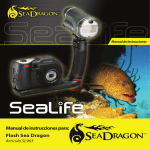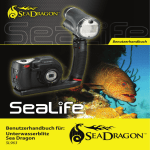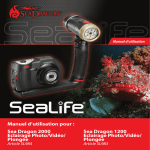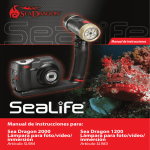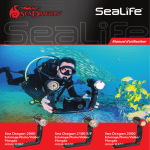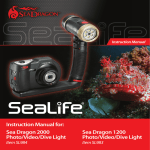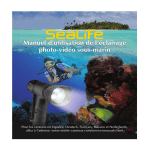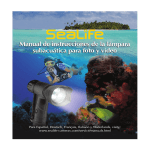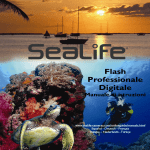Download Sealife Sea Dragon flash Troubleshooting guide
Transcript
Contents: I. Safety Warnings...........................................................3 II. Check What You Got ...................................................4 III. Product View with Call-outs ........................................5 IV. Preparing your flash ...............................................6-12 V. Preparing your camera .........................................13-14 VI. Testing your camera and flash ...................................15 VII. Adjusting your camera exposure and flash brightness .............................................16-19 VIII. External Flash adjustments ...................................20-22 IX. Maintaining a waterproof seal ...................................23 X. Care and maintenance ..............................................24 XI. Replacing the O-rings ...............................................25 XII. Expanding your Flex-Connect™ Lighting System ....................................................26-27 XIII. Great pictures made easy.....................................28-30 XIV. Troubleshooting Guide ....................................31-33 XV. Specifications .......................................................34 XVI. Parts and service...................................................35 http://www.sealife-cameras.com/service/manuals.html Español - Deutsch - Français - Italiano - Nederlands - Türkçe 2 I. Safety Warnings Turn OFF flash if foreign objects or water has entered the the battery compartment or internal electronics. Continued use in this state may cause fire or electrical shock. Contact the SeaLife service center for repairs. The battery chamber is waterproof. If no water has entered the flash head, the battery chamber may be cleaned without causing permanent damage to the internal electronics. Rinse the waterproof battery compartment with fresh water and allow the inside to dry. Replace the o-rings and apply lube. Install new, fully-charged batteries and test fire flash. If flash does not operate properly, please contact your local SeaLife dealer or the SeaLife service center in your country. Do not attempt to disassemble or access the electronic circuitry for any reason. The internal electronics uses high-voltage components that may result in severe electrical shock. Do not expose flash to heat or direct sunlight for prolonged periods of time. Observe all SCUBA dive safety rules and control your buoyancy at all times. Consult your dive instructor for dive safety questions. Visit www.sealife-cameras.com for updates to this manual and techniques on underwater photography. Check out the online guide called Great Pictures Made Easy. 3 II. Check What You Got Sea Dragon Flash (with attached diffuser, optical cable, grip and tray) Universal Flash Link Cable Adapter (SL992) O-ring Lube (SL9807) Spare O-rings 4 (SL98303) Sea Dragon Case (Small SL941 or Large SL942) O-ring remover (SL9808) III. Product view with call-outs Major parts 1– Flash head 9– Battery cap 2– Auto Bright light sensor 10 – Pressure safety valve 3– Diffuser (removable) 11– Power On/Off dial 4– Release buttons 5– Flex-Connect grip 12 – Test button (Auto Learn button) & Flash-ready light 6– Tray 7– Mounting screw 8– Rubber friction pad 13 – Brightness adjustment dial (Auto and Manual) 14 – Flex-Connect swivel connector 5 IV. Preparing your flash INSTALLING BATTERIES: 1) Unscrew waterproof battery cap. 2) Insert 4 new or freshly charged AA batteries according to the polarity markings. 3) Align cap notch with key and screw on waterproof battery cap. Lightly hand-tighten - Do not overtighten using excessive force or tools. Important: Make sure o-rings are perfectly clean, undamaged and lightly lubed. See page 23 for important information on maintaining a waterproof seal. 6 Attach camera (housing) to the tray. Carefully hand-tighten the mounting screw. Do not over tighten! Important: Only attach the flash to cameras/housings with minimum thread depth of 0.28" (7.2 mm) and using standard 1⁄4-20 tripod type thread. Never force or over-tighten the screw, or you may damage the housing seal and threads. 7 Connecting Flash Link optical cable to the external flash The Flash includes the Flash Link optical cable (item #SL96208). The optical cable is used to transmit light from the camera to the light sensor under the flash head. The external flash will fire when the light sensor detects light coming from the end of the cable. The external flash should come with the optical cable already attached to the flash head, but it is good to know how the cable can be removed and re-attached. 1. 2. 3. 1. Turn the cable locking screw counter-clockwise by about 2 rotations to loosen the clamping effect of the lock. Do not remove the locking screws. 2. Insert the optical cable into the hole of the cable lock until the cable stops [make sure cable is pushed up all the way]. 3. Turn the cable locking screw clockwise to lock the cable into place [finger tight only – Do not over tighten]. 8 Connecting Flash Link optical cable to SeaLife cameras For SeaLife cameras: Attach the other end of the optical cable to the camera adapter included with your SeaLife camera. 1. 2. 3. 1. Push the optical cable into one of the grooves so it’s locked firmly into position. The end of the cable must be directed at the camera’s flash but should not stick out beyond the adapter. The adapter has two grooves, so you can add another cable when using two flashes. 2. Attach the Flash Link adapter around the lens and push down until it locks firmly into place. There are two small locking mechanisms located on the outer edge of the adapter that should lock in to the camera housing. Make sure the adapter is oriented so it is aligned with the recessed flash window. 3. Once the cable and adapter is firmly attached, run the cables along the bottom of the flash base and up the flash arm. The cables should be secured to the flash arm using the Velcro ties provided with your flash accessory. 9 Connecting Flash Link optical cable to NON-Sealife cameras The universal cable adapter included with the flash allows you to attach the optical cable to any underwater camera housing. Step 1: Cut two small strips of adhesive backed hook-and-loop fastener Step 2: Remove adhesive backing strips and firmly attach above and below the flash window of the underwater housing. Make sure housing surface is clean and dry. Step 3: Unscrew cable adapter assembly and insert the larger half through the hole of the hook-n-loop fastener as shown. Make sure the “hook” side of the fastener is facing towards the wide end of the adapter (towards the camera). 10 Connecting Flash Link optical cable to NON-SeaLife cameras (continued) Step 4: Loosely screw on the smaller half of the adapter. Step 5: Insert the cable(s) so about 1mm sticks out of the other end and tighten the cable adapter assembly. Hand tighten – do not use tools. . Step 6: Attach fastener with cable to underwater housing so the cable is centered over the flash window. Step 7: User scissor to cut away excess fastener material. Important: Leave enough fastener material so it completely covers the flash window or else the stray light escaping from the flash window may cause backscatter. 11 Secure the Flash Link optical cable to the Grip Fasten optical cable by pushing into groove along inside of grip. 12 V. Preparing your camera Become familiar with how to operate your camera. Refer to your camera instruction manual for information on how to adjust the settings described in this manual. Here is the basic camera set-up for SeaLife and most other popular digital cameras. 1. Insert blank memory card. It’s good practice to regularly format memory card, but be careful, because this will erase all images on the card. 2. Make sure your camera battery(ies) are new or freshly charged before each dive. 3. Set SeaLife digital cameras to External Flash mode 4. For Non-SeaLife camera’s, do this: a. Set ISO to 100 (or less if available) but not Auto. b. Set White Balance to “DAYLIGHT” for better color. c. Set camera’s flash to FORCE ON. d. Select the highest image resolution. e. Some cameras offer manual shutter and aperture controls, which is recommended for advanced photographers only. 5. Inspect and clean camera housing and main O-ring in accordance with the camera/housing instructions. 6. Insert camera and seal the housing. 7. Take a test picture to make sure the camera’s flash fires. 13 Synchronize flash to non-SeaLife cameras The flash is factory set to work with your SeaLife camera. Follow these instruction to synch the flash to other underwater camera brands: 1. Turn OFF flash power. 2. Push and HOLD test button, and power ON flash. 3. The flash-ready light will be blinking. 4. With your camera connected to the optical cable and flash, take a test picture. Important: Make sure your camera's flash is set to FORCE ON so it always fires. 5. The flash-ready light will stop blinking. synchronized to your camera. 14 The flash is now VI. Test the camera and flash [above water] Now that you have made all the correct settings to your flash and camera, take a few test pictures to make sure the camera and external flash fires together. 1. Power on the camera and flash. a. Make sure the camera settings are set as described on page 13-14. b. Turn the flash brightness control dial on the back of the flash to Auto. 2. Wait for the flash-ready light to turn on. A blinking flash-ready light means the flash is recycling, which takes a few seconds. 3. Take a series of test picture while viewing the external flash from the side (Don’t look directly into the flash). 4. The camera’s flash and the external flash should be firing together. 5. If the external flash is not firing at the same time as the camera’s primary flash review the instructions on pages 6 through 14 or refer to the trouble shooting guide at the end of this manual. 15 VII. Adjusting your camera exposure and flash brightness This section will show you to make quick and easy adjustments to your camera and flash for achieving the best picture color and brightness. Make sure you become familiar with these basic adjustments before you dive with your new external flash. Overexposed picture Contrast and Colors are washed out Properly exposed picture Good contrast with vibrant colors. You can adjust your camera setting and/or external flash settings to achieve the best image exposure and color. 16 Camera adjustments: First, let’s learn about the different types of camera adjustments you can make. Scene modes Most digital cameras offer a variety of “Scene” modes which presets the camera’s controls depending on the type of picture you want to take. For SeaLife digital cameras, set the scene mode to Ext Flash (or Ext Flash Auto mode). For information on how to set your SeaLife camera’s scene mode, please refer to your SeaLife camera instruction manual. For non-SeaLife cameras, we recommend starting with AUTO scene mode. If your non-SeaLife camera has an “underwater” scene mode, don’t use it. These “underwater” modes are not intended for cameras using an external flash. Read your camera’s instruction manual to learn more about your camera’s scene modes. Experiment to find the best setting for you. ISO setting The term ISO (International Standards Organization) relates to the ability (or “speed”) of the camera’s sensor to accept light. The higher the ISO value, the more sensitive the camera is to light, resulting in a brighter but more grainy image. For SeaLife cameras, set the camera to Ext Flash mode (or Ext Flash Auto mode) and leave the ISO on Auto. Your SeaLife camera 17 is pre-programmed to automatically select the optimal ISO value for underwater flash pictures. For non-SeaLife cameras, select a lower ISO, like 50 or 100, because the picture will be sharper and less grainy. EV Compensation Your camera’s EV (Exposure Value) Compensation setting works very much like the ISO setting - Increase EV value to brighten images, and decrease EV value to darken pictures. Just like ISO, higher EV values will result in more grainy pictures. For SeaLife cameras, set the camera to Ext Flash mode (or Ext Flash Auto mode) and leave the EV Compensation at “0”. Your SeaLife camera is pre-programmed to automatically select the optimal EV value for underwater flash pictures. For non-SeaLife cameras, start with an EV value setting of -2 and make adjustments as necessary to achieve the best results. Avoid using + EV values. White Balance The camera’s White balance setting will match your camera’s image sensor to the color “temperature” of the primary light source. For SeaLife cameras, set the camera to Ext Flash mode and leave the White Balance on Auto. Your SeaLife camera is preprogrammed to match the color temperature of the flash. For non-SeaLife cameras, it is recommended to select the DAYLIGHT White Balance setting. 18 Camera’s flash setting Almost all digital cameras allow you to select the flash setting to Auto, Force ON, Force OFF or Red-Eye Reduction. For SeaLife cameras, set the camera to Ext Flash mode (or Ext Flash Auto mode). The SeaLife External Flash mode is a special underwater program that synchronizes the camera's exposure program, color balance and internal flash to the SeaLife external flash. The camera's flash will always fire in Ext Flash mode. For non-SeaLife cameras, select FORCE ON. Remember, your external flash will only fire if your camera’s flash fires. Manual exposure controls Some digital cameras include manual aperture and shutter speed controls, which requires advanced knowledge of photography principles. These controls are too advanced for this instruction manual. For SeaLife cameras, set the camera to Ext Flash mode (or Ext Flash Auto mode). The camera will automatically select the best aperture and shutter speed setting for underwater flash photography. Some SeaLife cameras include Ext Flash Manual mode. Please refer to the camera instruction manual for more details. For non-SeaLife cameras with manual exposure controls, you may want to take an underwater photography course to learn more about using manual controls. 19 VIII. External Flash adjustments Now that you are familiar with camera adjustments that effect picture color and brightness, this section will describe how to adjust the external flash. Flash Brightness control You can manually or automatically control the external flash brightness by adjusting the brightness control dial located on the back of the flash head. 10 is the brightest setting. Take some test pictures and experiment with the effect of the brightness control. If the test image is over-exposed (white or washed out colors), turn the power adjustment 1 or 2 steps clockwise to reduce the flash brightness and take another picture. Do this until the image exposure is satisfactory. If the test image is under exposed (dark), turn the power adjustment 1 or 2 steps counter-clockwise to increase the flash brightness and take another picture. Do this until the image exposure is satisfactory. Remember that the flash will only reach about 6 ft to 8ft (1.8m to 2.4m) depending on water visibility, so make sure to keep your underwater shooting distance within that range. If you turn the brightness control all the way clockwise, to AUTO, the flash will automatically adjust the brightness. 20 The Auto brightness feature works by measuring the amount of flash bouncing off the subject into the light sensor located on the front face of the flash. If the flash measures a high amount of light bouncing of the subject, it will cut-short the flash before it deploys the full flash and over-exposes the subject. The Auto setting works best in high-visibility water and closer shooting distances. Adjusting the Auto bright setting If the Auto setting consistently over- or under-exposes the picture, it can be adjusted to increase or decrease average brightness. If pictures are consistently over-exposed (white, washed-out), turn power on, set brightness dial to #1 (dot between 2 and "A") and hold the TEST button down for 4 seconds. The flash-ready light will blink a few times indicating the the new Auto bright setting is saved in memory. If pictures are consistently under-exposed (darker), repeat the above with the brightness dial set to #10. The Auto bright setting can be adjusted to any level between 1 and 10, with 10 being the highest average brightness. The factory setting is 5. 21 Aiming the external flash Make sure the flash head is directed at the subject before taking a picture. If the flash is not aimed correctly the image may appear underexposed (darker). Remember that subjects appear closer underwater than they do on land, so direct the flash a little over the intended target to compensate for this underwater effect. About the Flash Diffuser The diffuser is used primarily for close-up pictures to evenly illuminate the subject resulting in more vibrant colors. Pull off the diffuser for shooting distances beyond 2ft (60cm). 22 IX. Maintaining a waterproof seal (Before your dive) 1) The flash uses two O-rings to maintain a waterproof seal. 2) Every time you open the battery cap make sure the O-rings and sealing surfaces are clean, undamaged and lubricated. 3) Dampen a clean cotton cloth and wipe it around the o-ring and o-ring contact surfaces to remove any hair, sand or debris. 4) Carefully inspect the o-ring for cuts, tears or other damage. Replace o-rings if damaged. 5) Lube O-rings regularly. Apply a small amount of silicone lube on your finger tip and wipe it around the O-rings. Wipe off excess lubricant. The o-ring surface should have shiny, wet appearance. Important: Replace O-rings every year if damaged or not. Visit your local SeaLife dealer or www.sealife-cameras.com for information on ordering spare o-rings. 23 X. Care and maintenance (After your dive) 1) After each dive, soak the sealed flash in fresh water for about 15 minutes to remove any residual salt, sand and dirt. Never allow the saltwater to dry on the flash. 2) Push the test button about 10 times and rotate dials to clean any saltwater or sand trapped under the button. 3) Let the water drain out of the small holes located at the bottom of flex arm. (If using Flex Arms - see page 26 for optional accessories). 4) Dry off the flash with a towel. Make sure you and the flash are dry before opening the waterproof battery cap. 5) Remove battery before storing the flash. 6) Allow flash to thoroughly dry before storage. 7) Never use any detergents, cleaners, solvents or chemicals to clean the flash. 8) Insert a fresh Moisture-Muncher capsule (item #SL911) inside the battery compartment during storage to help keep the inside dry and free of corrosion or mildew during storage. 24 XI. Replacing the O-rings Replace the two O-rings if damaged or at least once per year. 1) Use the O-ring Remover tool provided to lift and remove the O-ring. 2) Carefully clean O-ring grooves and O-rings before installation 3) Install O-rings by stretching and lifting O-ring into the groove. Do not roll the O-ring or allow it to twist. 4) Apply a small amount of silicone lube on your finger tip and wipe it around the O-rings. Wipe off excess lubricant. The o-ring surface should have shiny, wet appearance. 25 XII. Expanding your Flex-Connect™ Lighting System Get brighter, more colorful results by expanding your Sea Dragon underwater camera system. The modular Flex-Connect arms, grips and trays easily clicks together to create these popular configurations: Pro Set Pro Duo Maxx Duo w/ single flash w/ light, flash and dual tray w/ light, flash, 2 flex arms and dual tray Flex Arm - “Click” on the Flex Arm for more creative lighting and easy aiming. Reduces backscatter by positioning the flash or light farther away from the camera. Add up to two arms per side. Each arm features 100° bending motion and adds 7” length in addition to the 5” grip (SL9901) Grip – Rubberized grip for a comfortable hold. Built-in channel to hide and secure optical cable. (SL9905) 26 Expanding your Flex-Connect™ Lighting System (continued) Select from three universal mounting trays: Dual Tray - Add another flash or light with the dual tray to double brightness, reduce shadowing and stabilized aiming control. Sold separately (SL9904) Micro Tray – This tiny tray is the perfect fit for compact cameras. Included with Sea Dragon 1200 Light or sold separately (SL9902) Single Tray – The standard single tray is ideal for medium size underwater cameras. Included with Sea Dragon 2000 Light and Digital Flash or sold separately (SL9903). Cold Shoe – Mount a light or flash over the camera for the most compact lighting solution available. Or use it to add a third light when using a dual tray. Easily slides on to cold shoe of SeaLife and most other underwater housings. (SL991). 27 XIII. Great pictures made easy There are plenty of challenges that photographers face in the underwater world. Please take some time to review SeaLife’s online guide called Great Pictures Made Easy by visiting www.sealife-cameras.com. The guide is located under the Technical Support menu. The following information summarizes the basic principles of underwater photography. 1. Crystal clear water Clear water is essential for good underwater pictures. Fine particles suspended in the water, like algae and sediments, cause low visibility and small spots to appear in your picture, commonly referred to as “backscatter”. Your external flash will help you reduce the backscatter effect because the flash only illuminates the outer rim of the floating debris. As a general rule, limit your shooting distance to 1/10 of the water visibility. 2. Limit your shooting distance to 6 ft (1.8m) Water is 800 times denser than air and quickly absorbs light. Your external flash has a limited reach of 6ft (1.8m) to 8ft (2.4m) depending on water visibility. Keep your shooting distance inside of 6 ft (1.8m). 4 ft (1.2m) is ideal. Consider the SeaLife Fisheye Lens accessory (SL975) which allows to keep a closer shooting distance and fit everything into the picture. 28 3. Move calmly and control your buoyancy Control your buoyancy at all times and set yourself up in the ideal position before taking a picture. This allows you to hold the camera steady and control your shooting distance. Good buoyancy control will help you avoid stirring up the sandy bottom which will cloud-up the water and cause backscatter. Controlling your buoyancy is very important for your diving safety so don’t take a picture until your buoyancy is under control. 4. Practice and experiment with your camera and external flash controls There is no better way to learn than from your mistakes. Become familiar with your camera controls so you can make quick adjustments depending on the conditions. Take the time to practice and experiment with different settings. Review your pictures and learn from your mistakes. 5. Learn how to compose a good picture Once you have mastered how to control the brightness level (exposure) of your picture, you will want to improve how to set-up a good picture. Here are some basic tips: a. Avoid shooting down on the subject from above. Shooting down usually results in a poor contrast because the subject blends into the background. If possible, shoot upwards from below the subject so you get a blue water background and better contrast. 29 b. Get the entire subject into your picture frame. Don’t cutoff the hands, fins or head of your subject. You can always crop you image later on your computer if you want. c. Learn the compositional rule of thirds. The rule states that an image can be divided into nine equal parts by two equally-spaced horizontal lines and two equallyspaced vertical lines. The four points formed by the intersections of these lines can be used to align features in the photograph. Professional photographers claim that aligning a picture with these points creates more energy and interest in the photo than simply centering the subject. 6. Always observe dive safety rules Do not let photography distract you from diving safely. 30 XIV. Troubleshooting Guide 1. External Flash does not fire when pushing TEST button. a. Power ON flash. Wait until the flash-ready light stops blinking (steady on). If the ready light does not turn on, make sure the battery polarity is correct and battery contacts are clean. b. Check the battery power. Replace or recharge batteries, if necessary. c. If above does not correct the problem, contact your local SeaLife dealer or SeaLife Service Center in your country. For a list of dealers, please visit www.sealife-cameras.com. 2. External Flash fires when pushing TEST button, but does not fire when triggered by camera. a. Make sure the power switch is set to “ON” position and the flash-ready light stops blinking (steady on). b. Take a test pictures and make sure your camera’s inner flash fires. c. Check that your camera settings are correct Refer to page 13-14 for more information. d. Make sure the external flash is correctly synched to your camera. Refer to page 14 for more information. e. Check that the Flash Link optical cable is attached correctly. Refer to page 9-12 for more information. 31 3. Flash fires sometimes but not all the time. a. This is normally caused by a damaged Flash Link optical cable or if the optical cable is not set-up correctly. Inspect the optical cable for damage and make sure the cable is attached and secured. b. Check that your camera settings are correct. Refer to page 9-12 for more information. 4. The recycle time is very long. a. This is normally the result of low battery power. The flash recycle time should not be more than 7 to 8 seconds when the flash is set to full power. b. Replace or recharge batteries if the recycle time is longer than 10 seconds. c. Remove diffuser for shooting distances beyond 2ft (60cm). 32 5. Dark areas in your pictures. a. This is mostly likely caused by not aiming the flash at the subject or if the flash is somehow obstructed. b. Areas further away from the camera will appear darker than closer objects. Maximum shooting distance is 6ft/1.8m to 8ft/2.4m depending on water visibility and the reflectivity of your subject. c. Check the brightness control setting. Turn counterclockwise to increase flash brightness. Turn clockwise to decrease flash brightness. d. The reflectivity of your subject will cause some areas to appear brighter than other areas. For example, dark coral needs more light than would white coral. Adjust flash intensity accordingly. 6. For updated trouble shooting information, refer to the SeaLife website at www.sealife-cameras.com or contact your local SeaLife dealer or service center for help. 33 XV. Specifications: Sea Dragon Digital Underwater Flash (item # SL963) Guide Number: Power adjustment range: Controls: Coverage angle: Color temperature: Power source: Battery life: Recycle time: Buoyancy: Housing material: Hardware: Weight: Dimensions: O-ring material: 20 (meters on land) at full power setting: 1.5m (meters on land) at low power 8% to 100% (Auto or Manual mode) Power (On/Off), Test(program), Brightness (Manual/Auto) 80° horizontal x 60° vertical (100° w/ diffuser included) 5700 degrees Kelvin 4 AA batteries (NiMH recommended) 150 flashes (+/-) Instant recycle time when power setting is less than 1⁄2 power. 5 seconds recycle time at full power (fresh batteries) Negative Fiber-reinforced polycarbonate marine grade stainless steel 18 ounces (509 grams) Head w/ batteries Head: 5" (12.7cm) x 4.5" (11.4cm) x 2.5"(6.4cm) Dual NBR o-rings (lube included) Note: Specifications subject to change without notice. 34 XVI. Parts and Service SeaLife warrants the original purchaser of this product, for a period of one (1) year from the date of purchase, that the product is free from defects in workmanship and materials. For a detailed warranty statement, please refer to the warranty information included with the product. In the event the original purchaser believes there is a defect in a product, it is recommended that the purchaser first visit www.sealife-cameras.com for updates on troubleshooting and technical tips and advice. The website also includes detailed information on how to get repair service. If it is determined that the product requires servicing, a return authorization number will be issued. Please contact your local SeaLife dealer or the importer in the country where the product was purchased for return information. Your local authorized SeaLife Dealer can also assist with product servicing and ordering replacement parts. The SeaLife website contains a list of authorized dealers and importers for your country. Pioneer Research, 97 Foster Road, Moorestown, NJ 08057 USA www.sealife-cameras.com 35





































